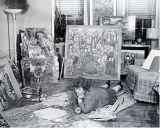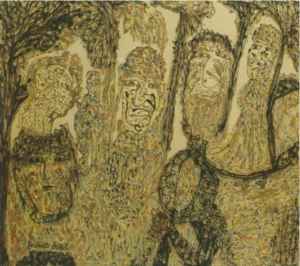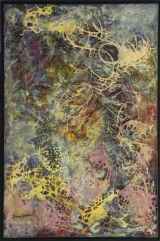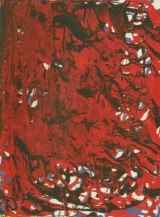The Forgotten Female Artist: Janet Sobel’s Struggle within the Abstract Expressionist Movement
In every modern art history class students learn about abstract expressionism by studying the major artists involved in the movement. They are usually as follows: Jackson Pollock, Mark Rothko, Willem de Kooning, Barnett Newman, Robert Motherwell, Arshile Gorky, Phillip Guston and Clyfford Still. What do all of these artists have in common? They are all men (and white, but that’s a whole other article!).
Throughout the history of art, women artists have been grossly overlooked. Was the proportion to male artists to women artists so imbalanced that there were simply no art by women to discuss or hang in galleries and museums? The answer of course is no, women artists have always been present, producing impressive art just as their male counterparts. It is far past time that these women be included in the conversation of art history.
Janet Sobel, an artist working in New York during the 1940s, is one of the overlooked and talented artists who was left out of art historical discourse. One of the most well-known facts about Sobel is her influence on Jackson Pollock. Sobel may have even been making full canvas drip paintings before Pollock did his. It is well recorded that Pollock saw Sobel’s work and remarked that it influenced him greatly. What little scholarship produced on Sobel thus far has focused so much on this single aspect of Sobel’s biography that the rest of her career has been overlooked. By focusing on the similarities between Sobel and Pollock, their differences have been ignored. These differences set Sobel apart as a truly unique, self-taught artist in her own right.

Sobel started painting at the age of forty-three, already a mother of five grown children, some of which had children of their own. She had absolutely no artistic training and began painting by experimenting with her son’s art supplies.[1] Thanks to the initial promotion of her son, Sol Sobel, her art soon caught the attention of artists, critics and other important figures in the art world, at which point her career rapidly advanced. However, this burst of popularity only lasted from about 1943 to 1947. In 1946, Sobel and her family moved from New York to New Jersey and the buzz from the art scene about her work began to fade due to this more remote location.[2] In addition to her removal from the New York art scene, her gender within the context of abstract expressionist artistic ideology also played a part in her exclusion from this mainstream movement of the 1940s and 50s.

Sobel’s move from figurative to abstract art followed that of many other abstract expressionists at the time. These artists expressed the same ideas in their abstract works as they did in their earlier figural works, but in a more universal way. Sobel was no different. The progression from figural work to abstraction with its emphasis on process was what defined the mature styles of many abstract expressionist artists, including Janet Sobel. Through the Glass from around 1944 shows her transition from figuration to abstraction. The figures fill the space and are brought to the front of the picture plane. This was an important step in her move towards abstract expressionism, which emphasized an all-overness quality of space. The strange figures and biomorphic forms are discernible through the use of Sobel’s expressive paint handling. In this painting, we can see that the process of creating abstract imagery is taking priority over the subject.
Finally, by around 1944 Sobel was moving towards her more advanced, mature abstract style. One of Sobel’s most beautiful abstract expressionist paintings was Milky Way from 1945. The painting contains a harmoniously balanced composition with its blend of soft color fields and dripped, active swirls. Within a few years, Sobel began to widely experiment with paint applications, as can be seen in work from about 1946 to 1948. In Untitled (JS-015) from 1946, the paint has been so thickly applied that it protrudes from the canvas, creating a visceral quality that begs to be touched.

The Museum of Modern Art, New York, NY
Digital Image © The Museum of Modern Art/Licensed by SCALA/Art Resource, NY
There are of course deeper issues at hand in regards to gender discrimination. Women such as Janet Sobel were working during a time when society immediately disregarded her and minimized her accomplishments as an artist because of her sex. In a review of her art in 1944 called “Art of the Week,” the author, who interestingly was also a woman, begins the article by pointing out the fact that Sobel, “buxom, pink-cheeked, round-faced, and dressed in a neat cotton print, looks just like any other Brooklyn housewife. You picture her over a stove on a warm Summer day, irritatedly shooing her grandchildren out of the kitchen, then relenting and giving them that mid-afternoon piece of cake.” Why is it that the first image we get of Sobel is not about the subject of the article (her art!) but about her dress and activity in the kitchen? This review and others like it from this time period give us a sense of the biased atmosphere that Sobel was working in. Really, did she ever have a chance at beating these preconceived assumptions?
The nature of abstract expressionism by definition helped to exclude women from the movement, making it a kind of “boy’s only club.” By the mid 1940s abstract expressionism came to stand for a heroic American artistic style that promoted the American ideals of universalism, individualism and freedom. This was in part due to the effect that WWII had on Americans’ notion of national identity. Male soldiers who fought in the war were celebrated in society at that time as almost heroic figures of democracy and freedom. Male artists such as Jackson Pollock, Barnet Newman and Mark Rothko embodied these ideals and were heroicized as the new American artists of the twentieth century. According to art historian Ann Eden Gibson, artists who did not follow this doctrine were subsequently pushed aside.[3] Perhaps Sobel’s themes in her art were not “universal” enough (or were not perceived as such) to belong to this creed. If this was the case, then it could be one reason that her art has been overlooked until recently. Gibson also says that thanks to the popularity of male artists like Pollock, “the identification of abstract expressionism with a virile American heroism was common currency.”[4] Thanks to the media attention given to Pollock, when audiences thought of abstract expressionism, they thought of the tough male artist, smoking a cigarette while splashing paint about the canvas in his barn. This new masculine art form in essence, excluded women. In American society during this time, the feminine represented passiveness and docility, which by its own definition were not characteristics of abstract expressionism. This assumption in the mid twentieth century meant that Sobel and other female artists like here would never rise to the same state of regard as their male counter parts.

Despite her short-lived fame, Sobel’s art can be appreciated today for its own merits and values, not the values of the male dominated abstract expressionist doctrines of the time in which she worked. The fact that she succeeded as much as she did without any official artistic training suggests an artistic genius that until now has been overlooked. It is far past time that we recognize Sobel and other extraordinary female artists who have been forgotten, or never recognized in the first place.
More disturbingly, even in our modern age women artists are still looked over and are not given the same praise and attention as men. For example, in museums and galleries, one-man shows by male artists greatly outnumber those by women. Again, is the proportion to male artists to women artists so imbalanced that there is not enough art by women to hang in modern galleries and museums? The answer of course is no, there are many great contemporary female artists working today. The problem is that they are lacking the recognition that they deserve. This inequality can be seen across a variety of art mediums. Similar to women visual artists, women working in the film industry are less recognized for their accomplishments compared to men. For example, the Academy Awards, which has been hosting its annual award ceremony since 1929, only very recently awarded a woman as best director. A recent study shows that of the top 100 domestic US grossing film women were only 29% of the major characters and had only 30% of all speaking roles on film. [5] The study points out that these figures have barely changed at all since the 1940s.
I could now comment and give examples of how the tides are turning and things are looking up for women artists. More exhibitions are being produced that feature women artists throughout history. More single-artist shows by women are being featured in galleries. However, the fact remains that whatever milestones have been made, women are still largely the minority of celebrated and acknowledged artists. No real change can be made until the institutions that have so greatly influenced our artistic culture, adjust their system of values enough to accept women as valid, credible artists. Museums, galleries, art critics and other institutions must lead the way in this endeavor, because like it or not, the majority of audiences look to them for validation of what is considered credible art and what is not.
Work Sited
[1] Bill Leonard, “This is New York,” Station WCBS, (December 16, 1946).
[2] Gail Levin, “Janet Sobel: Primitivist, Surrealist, and Abstract Expressionist,” Woman’s Art Journal 26, no. 1 (Spring-Summer 2005): 13.
[3] Ann Eden Gibson, Abstract Expressionism: Other Politics, (New Haven, CT: Yale University Press, 1997), 2.
[4] Ibid., 6.
[5] Suzanne Cowie, Yahoo! Shine, “New Study Reveals Shocking Statistics About Women in Hollywood,” Last modified March 14, 2014, https://shine.yahoo.com/work-money/study-reveals-shocking-statistics-women-hollywood-191500383.html.
What do you think? Leave a comment.











I believe while her entrance in the art world may have been shortlived and relatively inconsequential at the time, she likely had a significant impact on the core evolution of abstract art in the states.
It certainly is unfortunate that the work of women is generally under-appreciated in society; most likely it’s just a symptom of patriarchy and I firmly doubt that women will ever receive the same kind of recognition that men have. But at least we have people, such as yourself, writing about these kinds of topics and bringing acknowledgement to invaluable works that have been overlooked in the past. Good read!
Thank you for introducing me to Janet Sobel. Inspiring work.
Very informative, what an inspiring artist. Glad she’s finally receiving some recognition.
I agree that women artists are grossly underrepresented in art history. I do not think that putting the blame on the museums and galleries is a fair accusation.
In my opinion as a Professor of Art History; Sobel’s work is not as refined as many of her contemporaries. You mentioned Pollock and Rothko…they are certainly the 2 major abstract expressionists. They both began their artistic career as Surrealists artists and they had to work through concept for years before stumbling upon what we now call Abstract Expressionism. I would ask you for your opinion of Helen Frankenthaler as she is the major female artists of that period. Her work stands up to and is better than many of her contemporaries.
I applaud your effort to bring attention to an artist you enjoy. I would just be careful of waving the blame wand at those that inherited a centuries old problem with equality. Look at the History of Photography and how women are represented. It may shock you to see their impact on the genre.
Thanks for your comment! I don’t know if I meant to “blame” museums and galleries, but more to turn to them for change. The museums, galleries and art critics are the only ones with the power to make noticeable changes. I suppose Universities can also participate. They can add more women to their art history curriculum in order to effect a new generation of art historians. For what it worth, Sobel also went through a phase of what some called surrealism or primitivism (with some folk art influences in my opinion), for many years before she turned to abstraction. As for Frankenthaler, I have to admit that I am not as versed in her work and biography as I am with Sobel’s, but one thing I do know is that I never learned about her in any of my modern or ab ex art classes in Grad School.
That is shocking that Frankenthaler was not included in your courses. I began teaching Art History because I wanted to expose students to more than what our books give us. My courses are infused with minorities, women, photographers, designers and architects.
Re-reading my comment earlier, I did not intend for it to be combative or discouraging. It will be articles like yours and other contemporary writers that will help level the playing field.
No, I liked your earlier comment, it made me think more about my topic. Thanks again.
“Milky Way” is stunning.
As student of art history, who enjoys writing about works of art created by female artists, I really enjoyed reading this article and becoming familiar with Janet Sobel. I am currently in a class which concerns art after 1940 and I had not come across Sobel’s work, which I believe furthers your point. This was an engaging and good analysis of Sobel’s work and I could follow your arguments, especially those pertaining to her gender which often limited her. It seems like the work of female artists is the final frontier of the art history world and perhaps more women like you and I will further develop art history’s understanding of its female artists.
I completely agree with you. I’m not too surprised that you haven’t heard of her in your art history class. Hopefully you have learned about some other women artists in that class though.
Kim, you give a credible argument with documentation for the status of women in the arts. I found this article to be interesting and want to see more of Janet Sobel’s work. It is interesting to ponder the impact that women have had on the arts even without the exposure and publicity they deserve.
Thanks for your comment! I’m glad to see that others appreciate her like I do.
Important topic and I learned more than I’d previously known about this artist. Others writing about the exclusion of female artists from the pantheon abstract expressionism have usefully connected this bias to the historical context of the Cold War. One gender roles in the 1950s, Joanne Meyerowitz’s “Not June Cleaver” is a work you might enjoy.
So well written! I appreciate anyone who can write with both passion and clarity! I was instantly swept into the piece. And, thank you so much for bringing this artist to my attention. Wanting to learn more, I did a Google search on her name just now, and was dismayed to see how on many images of Pollock’s were on her page! I had to be persistent in my searching to find her work alone and not as a footnote. I think you really hit on the reason, too. Post war U.S., they wanted all the strong Rosey-the-Riveters to go back into the homes and disappear so that the returning men would not have to “compete.” I also wonder about her status as an immigrant–did that make her easier to ignore? Also, as a large, stocky woman myself, I know how people discredit or simply don’t even notice me. I wonder therefore, if her sturdy peasant looks just made her a little too “common” looking for other artists, gallery owners, and art promoters to be able to admit any intellectual power or depth to her work. She just wasn’t quirky, tortured, sexy, or flamboyant like the popular crowd – hard to market someone who looks like your cleaning woman. But thanks to your article, I am inspired by her. To think, starting so late in life, after raising a pack of children, that she could self-teach and achieve so much at such a time gives me hope. She obviously had a deep mind and soul to have created the images (I managed to find on the internet) with so little encouragement. I feel sorrow now, at the vast amount of treasure she could have left for us, if she had been given more encouragement and her own rightful place. Thank you.
What a great comment! It’s definitely got me thinking about some other angles of Sobel’s life.
Great article! As a student of art history I try to make a conscious effort to study female artists. Especially, the wives of famous artists such as Lee Krasner, Pollock’s wife, who should be given their dues.
Hi Kim. Interesting article. I’m Gamma Janet’s granddaughter. Learned to paint at her feet. Knew her very well as she babysat for me while mom worked.
You’re her granddaughter? That’s awesome! Boy would I love to pick your brain. I’m so glad you found my article! It’s actually part of a much longer paper, I wrote about Sobel for my master’s thesis. I’d be happy to send you a copy.
I learned of Janet Sobel during my recent visit to the Crystal Bridges Museum of American Art. Thanks for this article, giving more background on her life and work.
Is that the one in Arkansas?
This is a very interesting article, and very much in alignment with contemporary discussions of gender issues in art–and beyond. It is my understanding, through course work and personal studies, that many Abstract Expressionist painters (male, that is) actually have been considered to “transcend the dangerous castration caused by the female figure in art.” I spent an entire semester in a class called Displaying Gender, and this was a huge topic of discussion. Ironically, the class was taught by a female and we had more female students than male…
I’m Ashley Shapiro’s daughter, Janet Sobel’s great-granddaughter and I have several paintings and sketches that we saved. I’m particularly dismayed when over and over mention is made of her son Sol’s influence when it was really the other way around: there were many, many important and interesting people in the Sobel household long before Sol had a relationship with Peggy Guggenheim. Indeed, there’s a story of my mother (see above) as a child meeting John Dewey at the house . . .Once again, the lore is that a man–and here a subordinate one in her son–presented a woman to the world who would otherwise be unknown.
What a wonderful article! My daughter has two of Janel Sobel’s paintings and upon seeing them, I immediately fell in love with her art. I am invited to a
Come-As-An-Artist luncheon and I decided to attend portraying Janet Sobel. Your article has provided me with so much more insight on Sobel’s work than any other piece I have read.
Thank you so much!
Pauli Quann
I first encountered Janet Sobel’s painting, Hiroshima, at Crystal Bridges museum in Arkansas and it blew me away- it was breathtaking from across the room and drew me in like a magnet. The gender and level of training of the artist that created that work was beside the point to me, I just wanted to see who did it so I could find other works. I immediately started my research and was a little dismayed at the emphasis of gender, training and influence on Pollock assigned to her instead of availability of prints, gallery showings and notes of her own influences and musings. But ok, as a female, I get it, and feel fortunate to live in a time where this is less of an issue than it used to be. That said, it is wonderful to see that despite the fact this artist happens to be a self-taught female, her work is getting some of the recognition it deserves. Would still love to know more about availability of prints, gallery showings and notes of her own influences and musings though!
One of the pieces I love the most is her Milky Way done in 1945. As an artist that also started later in life, and a self taught artist, I love her story. Her art moves me.
I am writing a research paper on Janet Sobel for our local museum and was interested to see comments by her daughter and granddaughter, Rebecca and Ashley Shapiro, and wonder if there is anyway to contact either of them for more information.
Pat, I’m a professor at City University of New York and you can contact me there.